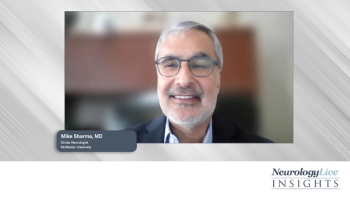
Improving Access to Endovascular Thrombectomy for Acute Ischemic Stroke
Lead author Amrou Sarraj, MD, discussed the findings of an assessment of more than 1900 stroke centers and the challenges in EVT access for stroke care.
Amrou Sarraj, MD
Recently, data from a study of 1941 stroke centers in the United States suggested that endovascular thrombectomy (EVT) centers are available within 15 minutes for less than 20% of the population in the United States, pointing to a need for both national and state efforts to improve access to EVT for
All told, flipping the top 10% of non-EVT centers to EVT capable would increase direct access within 15 minutes to an additional 7.5% (n = 2,094,953) nationwide, while bypassing non-EVT centers would result in an improvement in coverage for 16.7% (n = 51,689,614).
NeurologyLive spoke with lead author Amrou Sarraj, MD, chief, general neurology service, director, vascular neurology fellowship program, and associate professor of vascular neurology, UT McGovern Medical School, to find out more.
NeurologyLive: What prompted this work?
Amrou Sarraj, MD: Endovascular thrombectomy has revolutionized the management of acute ischemic stroke patients presenting with large vessel occlusion with a significant improvement of patients’ outcomes. However, timely access to this treatment is necessary to achieve the best functional outcomes. A comprehensive description of patients’ access to this highly effective treatment was much needed to understand the current status, identify the gaps and propose solutions and methodologies to enhance access. We undertook this work to describe the current population's access to endovascular thrombectomy and explore ways to improve it.
Is the cause of this challenge in access identifiable?
IV thrombolysis was the mainstay for acute ischemic stroke treatment for over 2 decades until several trials showed the efficacy and safety of endovascular thrombectomy in the last 5 years. Thus, most stroke care paradigms are geared towards delivering the patients to the closest hospital with the capability to provide IV thrombolysis. While adjustments are ongoing to these paradigms, the infrastructure and algorithms to provide better endovascular thrombectomy access are still in build-up stages.
Another challenge is how to identify patients with large vessel occlusion in the field and deliver them to endovascular thrombectomy capable centers. There are clinical trials assessing models and scores to improve pre-hospital identification and if those would result in better outcomes.
The third challenge is the number of endovascular thrombectomy centers and their distribution to provide this effective treatment to the highest possible US population. We have seen signs of progress on that front in our study with a 24% increment in the number of thrombectomy capable centers across the US between 2015 and 2017.
What can we do better to improve access to EVT therapy?
To optimize patients’ access to thrombectomy capable centers, we need better pre-hospital triaging protocols to identify patients who may have large vessel occlusion and taking them directly to thrombectomy-capable centers. The field also needs more thrombectomy-capable centers with optimal distribution to provide time-care delivery to the largest possible US population.
In our study, we implemented 2 methodologies and models to simulate the potential improvement with endovascular thrombectomy access. The first model was by increasing the number of hospitals that provide endovascular thrombectomy. The second model was by bypassing non-thrombectomy capable centers and transferring the patients directly to the nearest thrombectomy-capable center.
While results vary based on geography, population size, and density, transferring patients to the nearest thrombectomy-capable centers resulted in higher yield improvements of patients’ access. These models may help the stakeholders optimize the plans to improve thrombectomy access considering the availability of resources and population distribution and density.
Transcript edited for clarity.
REFERENCE
Sarraj A, Savitz S, Pujara D, et al. Endovascular Thrombectomy for Acute Ischemic Strokes: Current US Access Paradigms and Optimization Methodology. Stroke. Published online February 12, 2020. Accessed March 9, 2020. doi: 10.1161/STROKEAHA.120.028850
Newsletter
Keep your finger on the pulse of neurology—subscribe to NeurologyLive for expert interviews, new data, and breakthrough treatment updates.



































